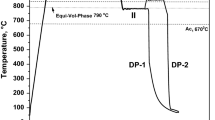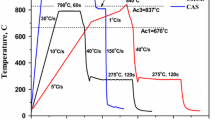Abstract
An experimental study has been conducted to quantify the effects of martensite plasticity on the mechanical properties of a commercial low-carbon (0.06 wt pct) dual-phase steel. The volume fraction and morphology (banded and more equiaxed) of the martensite second phase were systematically varied by control of the intercritical annealing temperature and the heating rate to this temperature. It was observed that the yield and tensile strengths were dependent on the volume fraction of martensite but not on the morphology. In contrast, the true uniform strain, fracture strain, and fracture stress were found to have a significant dependence on martensite morphology. These results were rationalized by considering an Eshelby-based model, which allowed for the calculation of the stress in the martensite islands for different morphologies and volume fractions. By comparing the stress in the martensite with an estimate of its yield stress, it was possible to rationalize the conditions under which martensite plasticity occurs. The implications of martensite plasticity affect the work hardening of the steels but most importantly the fracture properties. For conditions where martensite codeforms with the ferrite matrix, void nucleation is suppressed and the final fracture properties are dramatically improved.












Similar content being viewed by others
References
Rigsbee J.M., Vanderarend P.J. (1977) In: Davenport A.T (eds) Formable HSLA and Dual-Phase Steels. TMS-AIME, Warrendale, PA, pp. 56–86
Lanzillotto C.A.N., Pickering F.B. (1982) Met. Sci. 16:371–82
Marder A.R., Bramfitt B.L. (1979) In: Kot R.A., Morris J.W. (eds) Structure and Properties of Dual-Phase Steels. TMS-AIME, Warrendale, PA, pp. 242–59
Speich G.R., Miller R.L. (1979) In: Kot R.A., Morris J.W. (eds) Structure and Properties of Dual-Phase Steels. TMS-AIME, Warrendale, PA, pp. 145–82
Davies R.G., Magee C.L. (1979) In: Kot R.A., Morris J.W. (eds) Structure and Properties of Dual-Phase Steels. TMS-AIME, Warrendale, PA, pp. 1–19
Speich G.R. (1981) In: Kot R.A., Bramfitt B.L. (eds) Fundamentals of Dual Phase Steels. TMS-AIME, Warrendale, PA, pp. 3–45
Embury J.D., Duncan J.L. (1981) In: Kot R.A., Bramfitt B.L. (eds) Fundamentals of Dual Phase Steels. TMS-AIME, Warrendale, PA, pp. 333–45
Yi J.J., Yu K.J., Kim I.S., Kim S.J. (1983) Metall. Mater. Trans. A 14A:1497–1504
Pickering F.B. (1992) Constitution and Properties of Steels. Weinheim, Germany, pp. 77–79
Gladman T. (1997) The Physical Metallurgy of Microalloyed Steels. The Institute of Metals, London, pp. 325–36
Balliger N.K., Gladman T. (1981) Met. Sci. 15:95–108
J.M. Rigsbee, J.K. Abraham, A.T. Davenport, J.E. Franklin, J.W. Pickens, in Structure and Properties of Dual-Phase Steels, B.L.J.W.M.R.A. Kot, ed., TMS-AIME, Warrendale, PA, 1979, pp. 304–29
Klaar H.-J.E.-S.I.A., Hussein A.-H.A (1990) Steel Res. 61:85–92
Faral O.M., Hourman T. (1999) 41st Conf. on Mechanical Working and Steel Processing. ISS, Warrendale, PA, pp. 253–64
Waterschoot T., De Cooman B.C., Vanderschueren D. (2001) Ironmaking and Steelmaking, 28:185–90
Koo J.Y., Young M.J., Thomas G. (1980) Metall. Trans. A 11A:852–54
Bag A., Ray K.K., Dwarakadasa E.S. (1999) Metall. Mater. Trans. A 30A:1193–202
Kim N.J.T.G. (1981) Metall. Trans. A 12A:483–89
Pickering F.B. (1978) Physical Metallurgy and the Design of Steels. Applied Science Publishers, London
Sherman A.M., Davies R.G., Donlon W.T. (1981) In: Kot R.A., Morris J.W. (eds) Fundamentals of Dual-Phase Steels. TMS-AIME, Warrendale, PA, pp. 85–94
Bourell D.L., Rizk A. (1983) Acta Metall. 31:609–17
Liedel U., Traint S., Werner E.A. (2002) Comp. Mater. Sci. 25:122–28
Leslie W.C. (1981) The Physical Metallurgy of Steels. McGraw-Hill, New York, NY, pp 216–23
Davies R.G. (1978) Metall. Trans. A 9A:671–79
Marder A.R. (1982) Metall. Trans. A 13A:85–92
Su Y.L., Gurland J. (1987) Mater. Sci. Eng. 95:151–65
Shen H.P., Lei T.C., Liu J.Z. (1986) Mater. Sci. Technol. 2:28–33
Rashid M.S., Cprek E.R. (1978) Formability Topics—Metallic Materials. ASTM, Philadelphia, PA, pp. 174–90
Byun T.S., Kim I.-S. J. (1993) Mater. Sci. 28:2923–32
Huang J., Poole W.J., Militzer M. (2004) Metall. Mater. Trans. A 35A:3363–75
M. Mazanni: Ph.D. Thesis, The University of British Columbia, Vancouver, BC, 2006
Grange R.A. (1970) 2nd Int. Conf. on the Strength of Metals and Alloys. ASM, Metals Park, OH, pp. 861–76
Ramos L.F., Matlock D.K., Krauss G. (1979) Metall. Trans. A 10A:259–61
Brockenbrough J.R., Zok F.W. (1995) Acta Metall. Mater. 43:11–20
Bao G., Hutchinson J.W., McMeeking R.M. (1991) Acta Metall. Mater. 39:1871–82
Weng G.J. (1990) J. Mech. Phys. Solids 38:419–41
Ozturk T., Poole W.J., Embury J.D. (1991) Mater. Sci. Eng. A148:175–78
Ozturk T., Mirmesdagh J., Ediz T. (1994) Mater. Sci. Eng. A175:125–29
Langford G., Cohen M. (1969) Trans. ASM 62:623–38
Thomason P.F. (1990) Ductile Fracture of Metals. Pergamon Press, Oxford, United Kingdom
Steinbrunner D.L.M., Krauss D.K. (1988) Metall. Trans. A 19A:579–89
Duan X., Jain M., Metzger D., Kang J., Wilkinson D.S., Embury J.D. (2005) Mater. Sci. Eng. A394:192–203
Qiu G.J.Y.P.W. (1991) Int. J. Solids Struct. 27:1537–50
Acknowledgments
The authors gratefully acknowledge the support of NSERC (Canada) and Stelco, Inc., which made this work possible. The comments of J.D. Embury, C.W. Sinclair, and Olivier Bouaziz on the manuscript are also highly appreciated.
Author information
Authors and Affiliations
Corresponding author
Additional information
Manuscript Submitted: May 6, 2006.
Appendix
Appendix
Weng has developed a theoretical model based on the modified Eshelby model to estimate the stress-strain relations of the constituents in dual-phase materials (inclusion-matrix type composite microstructures).[36] The effect of inclusion shape and volume fraction has been taken into account in this model. The stress and strain coefficients are calculated through choosing the appropriate transformation strain and the Eshelby’s S-tensor for both the spherical and ellipsoidal inclusions. For spherical elastic inclusions, the average inclusion and matrix stresses are given by Eq. [A1]:
where σ (0)′ ij , σ (1)′ ij , and \( \ifmmode\expandafter\bar\else\expandafter\=\fi{\sigma }_{{ij}} ' \) are deviatoric components of the matrix, inclusion, and composite stresses; and b s0 and b s1 are the stress coefficients, respectively. For uniaxial tensile straining, σ ij is simply reduced to σ 11. The values of b s0 and b s1 can be calculated by Eq. [A2]:
at which \( \beta^{s}_0 = \frac{2} {{15}}.\frac{4-5\nu^{s}_0}{1-\nu ^{s}_0} \) is the distortional component of the Eshelby’s S-tensor, μ 1 is the shear modulus of the inclusion, μ s0 is the secant shear modulus of the matrix ( \( \mu ^{s}_{{\text{0}}} \, = \,\frac{{E^{s}_{{\text{0}}} }} {{{\text{2(1 + }}\nu ^{s}_{{\text{0}}} )}} \)), and f is the inclusion volume fraction. The secant Young’s modulus, E s0 , and secant Poisson’s ratio, v s0 , of the matrix are given by Eq. [A3]:
In these equations, E 0 and v 0 are the Young’s modulus and Poisson’s ratio of matrix, ε p(0)11 and σ (0)11 are the plastic strain and flow stress of matrix, respectively. Having the elastic constants and stress-strain relation of the matrix phase (E 0, v 0, ε p(0)11 and σ (0)11 ), the average stresses in both constituents as well as the stress ratios \( \left( {\frac{{\sigma _{11} ^{\left( 1 \right)} }}{{\sigma _{11} ^{\left( 0 \right)} }}\,{\text{and}}\,\frac{{\bar \sigma _{11} }}{{\sigma _{11} ^{\left( 0 \right)} }}} \right) \)can be calculated. Different equations may be used in the model to represent the stress-strain relation of the matrix phase. In the current work, a sixth-order polynomial fitted curve was found to adequately describe the experimental stress-strain relation of the ferrite matrix.
For ellipsoidal inclusions, the theoretical analysis is much more complicated, but it results in similar equations for calculations of the average stress in matrix, Eq. [A4]:
where 1/q s1 is the stress coefficient. The term q s1 is a function of the inclusion volume fraction, the components of Eshelby’s S-tensor, and the elastic constants of the inclusion and matrix.[43]
The model described previously was implemented in a spreadsheet program in an iterative approach so that the secant moduli could be updated. The magnitude of strain was incrementally approached, with the change in strain per calculation step being reduced until no further change in the solution was observed (i.e., a strain increment of 0.001). Figure A1 shows the results for the ratio of the inclusion stress (i.e., the stress in the martensite phase) to the matrix stress as a function of strain for various inclusion morphologies and volume fractions (which correspond to the experimental microstructures). It can be observed that for the case of spherical inclusion, the ratio is unity at the yield point and then increases, reaching a plateau value of 2.5 after a strain of ≈2 pct. On the other hand, for the case of ellipsoidal inclusions, the situation is more complicated. The saturation value of the stress ratio is (1) larger and (2) a function of the inclusion aspect ratio, and the transition strain is much greater, i.e., at least 5 pct.
Rights and permissions
About this article
Cite this article
Mazinani, M., Poole, W. Effect of Martensite Plasticity on the Deformation Behavior of a Low-Carbon Dual-Phase Steel. Metall Mater Trans A 38, 328–339 (2007). https://doi.org/10.1007/s11661-006-9023-3
Published:
Issue Date:
DOI: https://doi.org/10.1007/s11661-006-9023-3





